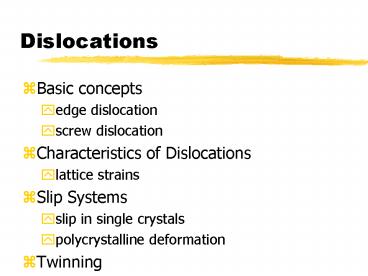Dislocations PowerPoint PPT Presentation
1 / 27
Title: Dislocations
1
Dislocations
- Basic concepts
- edge dislocation
- screw dislocation
- Characteristics of Dislocations
- lattice strains
- Slip Systems
- slip in single crystals
- polycrystalline deformation
- Twinning
2
Edge Dislocation
- In edge dislocations, distortion exists along an
extra half-plane of atoms. These atoms also
define the dislocation line. - Motion of many of these dislocations will result
in plastic deformation - Edge dislocations move in response to shear
stress applied perpendicular to the dislocation
line.
3
Edge Dislocation
- As the dislocation moves, the extra half plane
will break its existing bonds and form new bonds
with its neighbor opposite of the dislocation
motion. - This step is repeated in many discreet steps
until the dislocation has moved entirely through
the lattice. - After all deformation, the extra half plane forms
an edge that is one unit step wide - also called a Burgers Vector
4
Edge Dislocation
5
Edge Dislocation Examples
- Ni-48Al alloy edge dislocation
- the colored areas show the varying values of the
strain invariant field around the edge
dislocation - Shear was applied so that glide will occur to the
left. - Computer simulation
6
Screw Dislocation
- The motion of a screw dislocation is also a
result of shear stress. - Motion is perpendicular to direction of stress,
rather than parallel (edge). - However, the net plastic deformation of both edge
and screw dislocations is the same. - Most dislocations can exhibit both edge and screw
characteristics. These are called mixed
dislocations.
7
Screw Dislocation
8
Screw Dislocation Examples
- Ni-48Al alloy
- l001, 001(010) screw dislocation showed
significant movement. - Although shear was placed so that the dislocation
would move along the (010) it moved along the
(011) instead. - Computer simulation
9
Screw Dislocation
10
Mixed Dislocations
- Many dislocations have both screw and edge
components to them - called mixed dislocations
- makes up most of the dislocations encountered in
real life - very difficult to have pure edge or pure screw
dislocations.
11
Mixed Dislocations
12
Mixed Dislocations
13
Characteristics of Dislocations
- Lattice strain
- as a dislocation moves through a lattice, it
creates regions of compressive, tensile and shear
stresses in the lattice. - Atoms above an edge dislocation are squeezed
together and experience compression while atoms
below the dislocation are spread apart abnormally
and experience tension. Shear may also occur near
the dislocation - Screw dislocations provide pure shear lattice
strain only.
14
Characteristics of Dislocations
15
Characteristics of Dislocations
- During plastic deformation, the number of
dislocations increase dramatically to densities
of 1010 mm-2. - Grain boundaries, internal defects and surface
irregularities serve as formation sites for
dislocations during deformation.
16
Slip Systems
- Usually there are preferred slip planes and
directions in certain crystal systems. The
combination of both the slip plane and direction
form the slip system. - Slip plane is generally taken as the closest
packed plane in the system - Slip direction is taken as the direction on the
slip plane with the highest linear density.
17
Slip Systems
- FCC and BCC materials have large numbers of slip
systems (at least 12) and are considered ductile.
HCP systems have few slip systems and are quite
brittle.
18
Slip in Single Crystals
- Even if an applied stress is purely tensile,
there are shear components to it in directions at
all but the parallel and perpendicular
directions. - Classified as resolved shear stresses
- magnitude depends on applied stress, as well as
its orientation with respect to both the slip
plane and slip direction
19
Slip in Single Crystals
20
Polycrystalline Deformation
- Slip in polycrystalline systems is more complex
- direction of slip will vary from one crystal to
another in the system - Polycrystalline slip requires higher values of
applied stresses than single crystal systems. - Because even favorably oriented grains cannot
slip until the less favorably oriented grains are
capable of deformation.
21
Polycrystalline Deformation
- During deformation, coherency is maintained at
grain boundaries - grain boundaries do not rip apart, rather they
remain together during deformation. - This causes a level of constraint in the grains,
as each grains shape is formed by the shape of
its adjacent neighbors. - Most prevalent is the fact that grains will
elongate along the direction of deformation
22
Polycrystalline Deformation
23
Dislocation Movement across GBs
- As dislocations move through polycrystalline
materials, they have to move through grains of
different orientations, which requires higher
amounts of energy, if the grains are not in the
preferred orientation. - As they travel between grains they must be
emitted across the grain boundary, usually by one
half of a partial dislocation, and then
annihilated by the second half at a time slightly
after the first one. - LINK TO HELENA2.gif
24
Twinning
- A shear force which causes atomic displacements
such that the atoms on one side of a plane (twin
boundary) mirror the atoms on the other side. - Displacement magnitude in the twin region is
proportional to the atoms distance from the twin
plane - takes place along defined planes and directions
depending upon the system. - Ex BCC twinning occurs on the (112)111 system
25
Twinning
26
Twinning
- Properties of Twinning
- occurs in metals with BCC or HCP crystal
structure - occurs at low temperatures and high rates of
shear loading (shock loading) - conditions in which there are few present slip
systems (restricting the possibility of slip) - small amount of deformation when compared with
slip.
27
Twinning

